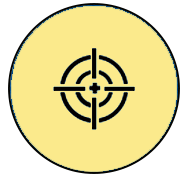
Flapping Bird – Type 1
 Objective
Objective
To guide teachers in creating a puppet of a flapping bird for story-telling and other educational purposes.
Estimated time to create the Flapping Bird – Type 1
30 to 45 Minutes
Materials required for creating Flapping Bird – Type 1
- A4 size colour paper – 2 sheets
- Googly eyes
- Pencil
- Fevicol
- Scissors
- Transparent tape
Preparation for Activity
- Use lightweight A4 coloured paper (preferably 70-80 gsm) to ensure smooth flapping movement.
- Keep all necessary materials ready in advance: scissors, glue, googly eyes, scale, pencil and a template (optional).
- If you are using hot glue instead of Fevicol, ensure that it is suitably heated and is ready for use.
- Make one sample model in advance and test the flapping action to ensure it works well before the class activity.
- If students are participating, use child- safe scissors for safety.
Procedure
- Fold the A4 colour paper in half. Draw and cut the shapes of the wings and tail.
- You will get a pair of symmetrical wings and tail. Set them aside.
- Fold a small piece of paper into two. Draw and cut a rough circular shape for the head of the bird. You will get a pair of similar pieces for the head.
- Fold a rectangular strip of paper approximately 3 inches wide into half. This will be used for the body of the bird (shown in light blue colour in the picture).
- At one end of the folded body, apply fevicol on both inner sides and stick the two head pieces one on each side.
- Now, take one of the wings, apply fevicol only along the inner edge. Lift one flap of the body and stick the wing on the inside, near the head.
- Repeat the same for the other wing—fixing it on the inner side of the opposite flap. Ensure both wings are aligned properly and are symmetrical.
- Attach the tail on the side of the body, just near the wing portion. Repeat the same on the other side.
- Trim the body portion in the middle section of the body for a smooth, curved shape.
- Draw and cut two similar pieces for the beak. Apply fevicol to the broader edge of each piece and fix them on either side of the head.
- Now, to operate the puppet, we need to attach two paper strips to the wings. For this, take a thin strip of paper, fold it into four folds and secure the end with fevicol. Flatten the strip. Prepare one more strip in the same way.
- Bend one end of this folded strip by about one inch.
- Apply fevicol and stick this bent end to the underside of the wing, approximately at the centre of the wing. Bend the remaining length of the strip downward.
- Similarly, stick the second strip to the other wing in the same manner. Allow both to dry completely. Now the pulling strips are ready to flap the wings.
- Stick the loose flaps together at the tail end to close the body. Finally, fix the googly eyes on either side of the head.
- Allow a few minutes for the fevicol to dry and your flapping bird puppet is ready.
- To operate the puppet, gently pull the strips to make the wings flap up and down.
Step by Step Pictures to create the puppet
Important Tips
- Ensure the wings are even and symmetrical for smooth flapping.
- Make sharp folds to give the puppet a neat and defined structure.
- Glue the wings uniformly on both sides to maintain proper balance.
- Keep the pulling strips long enough to allow free movement without resistance.
- While making the puppet, replicate the character illustration from the children’s textbook. Once completed, refer to the puppet by the character’s name as mentioned in the textbook. This helps children connect the activity with the lesson and improves retention.
- Use the puppet thoughtfully during the session. Narrate the story in an engaging and humorous manner. You may also include deliberate mistakes to encourage children to correct them—this makes the storytelling interactive and helps deepen their understanding.
Precautions
- Always keep the puppet’s face directed towards the audience.
- The Puppet Master’s focus should remain on the puppet at all times.
- Only the puppet that is “speaking” should be animated; all other puppets should remain still.
Troubleshooting:
- If the wings are not flapping, check whether the pulling strip is too tight or too loose.
- Ensure the wings are not glued too close to the body.
- If the paper is tearing, avoid pulling too hard. Reinforce the joints with tape if needed.
- If the flapping is unbalanced, ensure both wings are of the same size and shape.
 Notes to the Teacher
Notes to the Teacher
Puppets can be used to demonstrate bird movement, air resistance or for storytelling.
Let the students try gently pulling the strips to observe the motion.
Encourage students to make their own bird puppets in pairs or groups for better engagement.
Hang the finished puppets in the classroom as decoration and for future revision.
Using puppets helps develop motor skills such as hand-eye coordination. Additionally, they enhance communication and social skills, improve focus and concentration and help teach concepts and values.
Using the Learning Teaching Material
The teacher can present a simple ‘Puppet Show’ as a demonstration. Students can be encouraged to create their own puppets and participate in a classroom ‘Puppet Show’.
Video: How to use Learning Teaching Material
| Source and Attribution of images All images used in the above Assets and Aids are originally created. |
| This digital material has been developed by the Sri Sathya Sai Vidya Vahini Inclusive Education Project, a unit of Sri Sathya Sai Central Trust, Prasanthi Nilayam, as a collaborative offering in the service of our nation. |